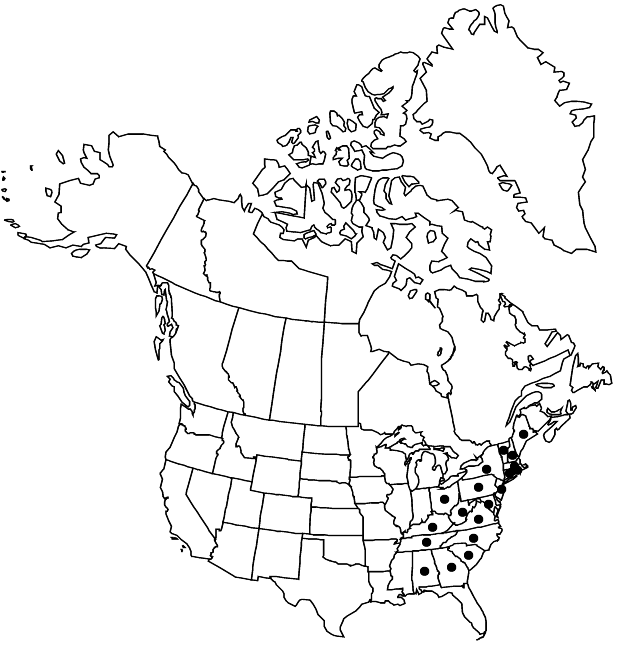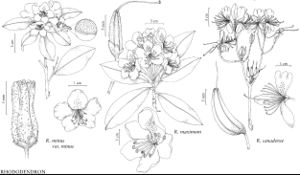Rhododendron maximum
Sp. Pl. 1: 392. 1753 ,.
Shrubs or trees, to 10 m, sometimes rhizomatous. Stems: bark smooth to vertically furrowed, shredding; twigs multicellular stipitate-glandular-hairy and eglandular-hairy (hairs basally branched, crisped/matted), glabrate in age. Leaves persistent; petiole multicellular-hairy (hairs ± branched), often glabrescent; blade oblong to obovate or elliptic, (6–)9–20(–31) × (1.5–)2–5(–8) cm (length/width ratio 2.4–8), thick, coriaceous, margins entire, revolute to ± plane, glabrous or sparsely hairy (hairs branched), apex acuminate to sometimes acute, surfaces scattered stipitate-glandular-hairy and eglandular-hairy (hairs forming dense mat, basally branched, crisped, abaxially becoming sticky and matted, forming ± scaly or continuous, pale, shellaclike coating, smooth to slightly roughened, hairs ± deciduous adaxially). Floral bud scales stipitate-glandular-hairy, eglandular-hairy (hairs ferruginous, crisped), and short unicellular-hairy abaxially, margins hairy (hairs branched, long-celled). Inflorescences 10–25-flowered; bracts similar to bud scales. Pedicels 17–60 mm, multicellular stipitate-glandular-hairy. Flowers opening after development of leaves (of flowering shoots), erect to horizontal, not or only slightly fragrant; calyx lobes 2–6 mm, stipitate-glandular-hairy; corolla white to pink, rarely deep pink to purple, with yellowish green spots on upper lobe, campanulate, 20–36 mm, scattered stipitate-glandular-hairy on outer surface, petals connate, lobes 10–23 mm, tube gradually expanding into lobes, 7–16 mm; stamens 10, included, ± unequal, 14–26 mm; (ovary stipitate-glandular-hairy). Capsules borne on erect pedicels, 8–20 × 4–6.5 mm, stipitate-glandular-hairy. Seeds without distinct tails, flattened portion of testa well developed at each end; testa expanded, dorsiventrally flattened, loose. 2n = 26.
Phenology: Flowering summer.
Habitat: Stream banks, mesic woods
Elevation: 0-1900 m
Distribution

Ala., Conn., Ga., Ky., Maine, Md., Mass., N.H., N.J., N.Y., N.C., Ohio, Pa., R.I., S.C., Tenn., Vt., Va., W.Va.
Discussion
Individuals of Rhododendron maximum are beautiful, cold-hardy shrubs and are frequently cultivated as ornamentals. Hybrids with R. catawbiense occur. This species has been attributed in standard floras to eastern Canada but not confirmed there by specimens.
Selected References
None.
